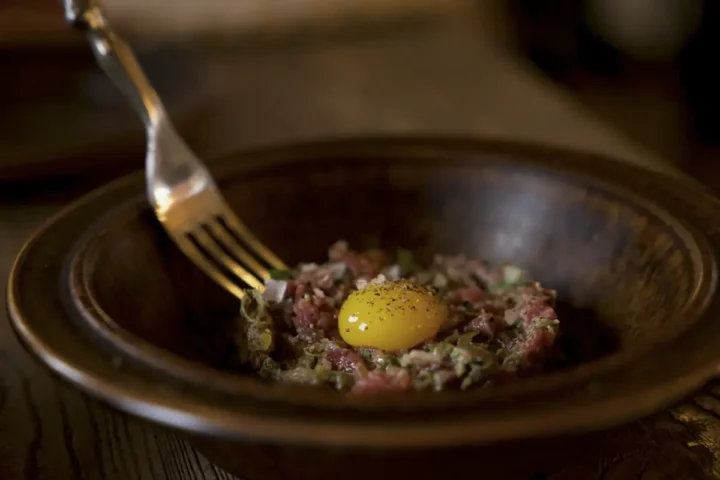You Don’t Need to Be a Chef to Nail Steak Tartare at Home
Steak tartare may carry the aura of fine dining, but it doesn’t need to stay behind a restaurant’s double doors. With its delicate balance of raw beef, briny bursts, and creamy richness, this dish delivers bold flavor with a minimalist touch. It’s an invitation to slow down and savor—every bite a reminder that simplicity can be elegant.
Bringing steak tartare into your kitchen is less about aiming for perfection and more about trusting simple steps done well. Start with a clean cut of fresh meat, prep with care, and let each ingredient keep its character. What seems polished on the plate is actually built from quiet attention—small choices that add up to something surprisingly easy, satisfying, and worth repeating.

Choosing the Right Cut Is Where It All Begins
Great steak tartare begins with the right cut of meat. Lean options like top round or eye of round offer tenderness and flavor, forming a solid base. Using whole cuts gives a cleaner texture and better look and feel. Avoid pre-ground beef—it usually lacks the freshness and quality needed, which can lead to a disappointing result.
Trimming and dicing the beef by hand gives you more control over quality, which results in a better tartare. Doing it yourself means you can get a consistent texture that enhances the flavor. For example, cutting away any sinew or silver skin avoids unpleasant chewiness in the final dish. When choosing your meat for steak tartare, go for the freshest you can find—quality really counts here.
Knife Skills: Improving Technique for Precision and Texture
How you cut the meat directly shapes its texture and flavor. Use a chilled chef’s knife for clean, precise slices that protect the beef’s tenderness. Instead of hacking through it, let the blade glide—sharp and steady. Aim for small, ¼-inch cubes so each piece soaks up seasoning without turning mushy.
Keep ingredients separate while prepping. Shallots and capers deserve their own space to keep flavors distinct until it’s time to mix. These quiet decisions—separating boards, sharpening blades—add finesse. Each cut contributes to the final dish, so take your time. Precision here doesn’t just show—it tastes better, too.
Seasoning Isn’t Just Salt—Balance Is Everything
What sets steak tartare apart is the way its flavors come together in layers. A rich blend of egg yolk, sharp mustard, and a splash of acid creates a creamy base that clings to each cube of beef. Every bite delivers contrast—bright, bold, and smooth—without overshadowing the meat’s natural depth.
Delicate additions like finely chopped shallots and briny, rinsed capers add complexity without stealing the spotlight. A drizzle of neutral oil rounds it out with a subtle silkiness. Adjust the elements as you go—taste leads the way, and the right balance makes the dish feel complete yet effortlessly light.
Assembly Timing Makes or Breaks the Texture
Timing matters just as much as technique when making steak tartare. Keeping everything cold—from the beef to the mixing bowl—helps preserve the dish’s clean texture and fresh flavor. Cold ingredients stay firmer, giving each bite that signature tenderness without turning soft or mushy.
Hold off on adding salt or acid until the very end. Too early, and they’ll start to cure the beef, dulling its texture and brightness. Use tools like a ring mold for neat presentation, and plate on something chilled to keep the experience crisp from first glance to final bite. These details shape how the dish lands.
Serving Strategy: From Plate to First Bite
Presentation doesn’t just complete the dish—it enhances how it’s experienced. Serve the tartare on a chilled plate to keep the beef cool and glistening. Pair it with crisp toast points or paper-thin crostini for crunch, and a handful of peppery greens to add color and bite. These sides don’t just complement the texture—they create contrast that brings each forkful to life.
Offer small garnishes like flaky sea salt, lemon wedges, or chopped herbs on the side. Let guests build each bite to their taste. This kind of interactive plating makes the dish feel personal, improved, and quietly celebratory.
Making steak tartare at home is less about getting the hang of a recipe and more about embracing the process. Choose a fresh, lean cut, dice it with attention, and let the ingredients speak for themselves. Keep everything cold, add salt and acid just before serving, and let the dish come together in the moment.
Focus on clean technique, subtle seasoning, and thoughtful plating. Add toast, greens, and a few simple garnishes to invite interaction and variety. The beauty of tartare lies in its raw honesty—each bite shaped by care, taste, and timing. With a light touch, it becomes something memorable and truly satisfying.


